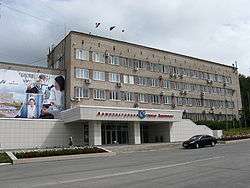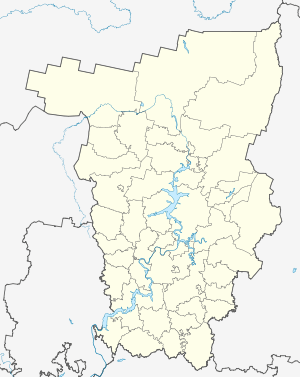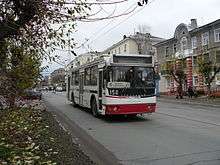Berezniki
| Berezniki (English) Березники (Russian) | |
|---|---|
| - City[1] - | |
 Berezniki City Administration building | |
.svg.png) Location of Perm Krai in Russia | |
 Berezniki | |
|
| |
_(1981).png) |
|
|
| |
| Administrative status (as of December 2011) | |
| Country | Russia |
| Federal subject | Perm Krai[1] |
| Administratively subordinated to | city of krai significance of Berezniki[1] |
| Administrative center of | city of krai significance of Berezniki[1] |
| Municipal status (as of October 2009) | |
| Urban okrug | Berezniki Urban Okrug[2] |
| Administrative center of | Berezniki Urban Okrug[2] |
| Head | Sergey Dyakov |
| Representative body | City Duma[3] |
| Statistics | |
| Population (2010 Census) | 156,466 inhabitants[4] |
| - Rank in 2010 | 112th |
| Time zone | YEKT (UTC+05:00)[5] |
| Founded | 1873[6] |
| City status since | 1932[6] |
| Postal code(s)[7] | 618400-618426 |
| Dialing code(s) | +7 3424 |
|
| |
| Berezniki on Wikimedia Commons | |
Berezniki (Russian: Березники́) is a city in Perm Krai, Russia, located on the banks of the Kama River, in the Ural Mountains. Population: 156,466 (2010 Census);[4] 173,077 (2002 Census);[8] 201,213 (1989 Census).[9]
Etymology
The name Berezniki is derived from a birch forest originally situated on the city's location.
History
It was founded in 1873.[6] City status was granted to it in 1932[6] as its industry was rapidly expanding under Joseph Stalin.
Administrative and municipal status
Within the framework of administrative divisions, it is incorporated as the city of krai significance of Berezniki—an administrative unit with the status equal to that of the districts.[1] As a municipal division, the city of krai significance of Berezniki is incorporated as Berezniki Urban Okrug.[2]
Economy


After the dissolution of the Soviet Union in 1991, the city's population dropped due to increased unemployment. Nevertheless, the city was able to keep its main industries on track. Large chemical plants such as titanium and sodium factories as well as several huge Potassium, Magnesium and Potash mines are operational in Berezniki.
The potash mine, owned by Uralkali, was the basis of the fortune of Dmitry Rybolovlev who sold his interest in 2010 to Suleyman Kerimov. Mine supports in the huge underground mine, about 1,000 feet beneath the city, consist of soluble salt which is being dissolved by water flooding into the mine. The city, a former Soviet era labor camp, was built near the work site, over the mine. Several sinkholes, some huge, have opened within the city. The situation requires round-the-clock monitoring. The problem is believed to be limited to a small part of the mine which was not filled properly and to be limited in its future impact, but relocation of the city is under consideration.[10] The largest sinkhole, locally dubbed, "The Grandfather" by 2012, was 340 yards wide, 430 yards long, and 780 feet deep.[10] When it opened in 2007[11] the hole was initially 80m long, 40m wide and 200m deep.[12] The sinkhole was expected to expand, and destroy part of the only rail line which leads to and from the potash mines, and, being that Berezniki produces around 10% of the worlds potash, this would lead global demand towards Canada, potentially damaging the local economy. Nobody was injured when the sinkhole appeared.
Berezniki has a theater and a museum of regional history.
Notable people
Russia's first president Boris Yeltsin attended Pushkin High School in Berezniki.
Russian billionaire Dmitry Rybolovlev controlled the leading Berezniki potash mines during 2000 — 2011.
Transportation
Berezniki is served by the Berezniki Airport, which mainly serves helicopters. A railway station is closed since it is located in the sinkhole area and has been damaged beyond repair. In the city public transport service is operated with trolleybuses.
Trivia
Every year from July 17th to the 20th the town celebrates its mosquitoes. They have music, dancing and a "most delicious girl" competition. In the competition, the girls stand for 20 minutes in their shorts and vests, and the one who receives the most bites wins.[13]
References
Notes
- 1 2 3 4 5 Law #416-67
- 1 2 3 Law #1983-434
- ↑ Website of City Duma
- 1 2 Russian Federal State Statistics Service (2011). "Всероссийская перепись населения 2010 года. Том 1" [2010 All-Russian Population Census, vol. 1]. Всероссийская перепись населения 2010 года (2010 All-Russia Population Census) (in Russian). Federal State Statistics Service. Retrieved June 29, 2012.
- ↑ Правительство Российской Федерации. Федеральный закон №107-ФЗ от 3 июня 2011 г. «Об исчислении времени», в ред. Федерального закона №271-ФЗ от 03 июля 2016 г. «О внесении изменений в Федеральный закон "Об исчислении времени"». Вступил в силу по истечении шестидесяти дней после дня официального опубликования (6 августа 2011 г.). Опубликован: "Российская газета", №120, 6 июня 2011 г. (Government of the Russian Federation. Federal Law #107-FZ of June 31, 2011 On Calculating Time, as amended by the Federal Law #271-FZ of July 03, 2016 On Amending Federal Law "On Calculating Time". Effective as of after sixty days following the day of the official publication.).
- 1 2 3 4 Энциклопедия Города России. Moscow: Большая Российская Энциклопедия. 2003. p. 46. ISBN 5-7107-7399-9.
- ↑ Почта России. Информационно-вычислительный центр ОАСУ РПО. (Russian Post). Поиск объектов почтовой связи (Postal Objects Search) (Russian)
- ↑ Russian Federal State Statistics Service (May 21, 2004). "Численность населения России, субъектов Российской Федерации в составе федеральных округов, районов, городских поселений, сельских населённых пунктов – районных центров и сельских населённых пунктов с населением 3 тысячи и более человек" [Population of Russia, Its Federal Districts, Federal Subjects, Districts, Urban Localities, Rural Localities—Administrative Centers, and Rural Localities with Population of Over 3,000] (XLS). Всероссийская перепись населения 2002 года [All-Russia Population Census of 2002] (in Russian). Retrieved August 9, 2014.
- ↑ Demoscope Weekly (1989). "Всесоюзная перепись населения 1989 г. Численность наличного населения союзных и автономных республик, автономных областей и округов, краёв, областей, районов, городских поселений и сёл-райцентров" [All Union Population Census of 1989: Present Population of Union and Autonomous Republics, Autonomous Oblasts and Okrugs, Krais, Oblasts, Districts, Urban Settlements, and Villages Serving as District Administrative Centers]. Всесоюзная перепись населения 1989 года [All-Union Population Census of 1989] (in Russian). Институт демографии Национального исследовательского университета: Высшая школа экономики [Institute of Demography at the National Research University: Higher School of Economics]. Retrieved August 9, 2014.
- 1 2 "A Russian City Always on the Watch Against Being Sucked Into the Earth" article by Andrew E. Kramer in The New York Times April 10, 2012
- ↑ English Russia » A Giant Sinkhole
- ↑ Virtual Globetrotting: 2007-11-02 - Another sinkhole threatens Russia
- ↑ http://www.bbc.com/news/blogs-news-from-elsewhere-33525015
Sources
- Законодательное собрание Пермской области. Закон №416-67 от 28 февраля 1996 г. «Об административно-территориальном устройстве Пермского края», в ред. Закона №504-ПК от 9 июля 2015 г. «О внесении изменений в Закон Пермской области "Об административно-территориальном устройстве Пермского края"». Вступил в силу с момента опубликования. Опубликован: "Звезда", №38, 12 марта 1996 г. (Legislative Assembly of Perm Oblast. Law #416-67 of February 28, 1996 On the Administrative-Territorial Structure of Perm Krai, as amended by the Law #504-PK of July 9, 2015 On Amending the Law of Perm Oblast "On the Administrative-Territorial Structure of Perm Krai". Effective as of the moment of publication.).
- Законодательное собрание Пермской области. Закон №1983-434 от 27 декабря 2004 г. «Об утверждении границ и о наделении статусом муниципального образования "Город Березники" Пермского края», в ред. Закона №499-ПК от 16 октября 2009 г «О внесении изменений в отдельные законодательные акты Пермской области и Коми-Пермяцкого автономного округа». Вступил в силу через десять дней со дня официального опубликования. Опубликован: "Звезда", №217–218, 30 декабря 2004 г. (Legislative Assembly of Perm Oblast. Law #1983-434 of December 27, 2004 On Establishing the Borders and on Granting the Status to the Municipal Formation of the "City of Berezniki" of Perm Krai, as amended by the Law #499-PK of October 16, 2009 On Amending Various Legislative Acts of Perm Oblast and Komi-Permyak Autonomous Okrug. Effective as of the day which is ten days following the day of the official publication.).
Further reading
- "A Russian City Always on the Watch Against Being Sucked Into the Earth" article by Andrew E. Kramer in The New York Times April 10, 2012